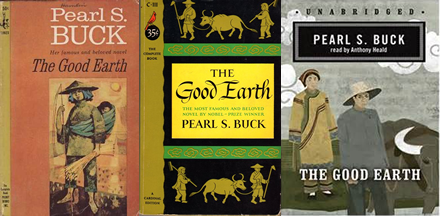“… when he was poor and labored in the fields himself, she left her bed even after a child was born and came to help him in the harvest fields….”
That meek, selfless, stoical, persevering, unfailingly-devoted and always-dignified farmer’s wife is the abiding good in Pearl Buck’s The Good Earth.
Pearl Buck, Nobel Laureate for Literature, was a child of American missionaries. She spent her early years in China. Through her Pulitzer-Prize-winning widely-translated novel, she acquainted the rest of the world with the people, the customs and mores, of that country, prior to the revolution that would, decades later, get the country top billing on the geo-political stage.
Likened to The Grapes of Wrath and to Charles Dickens’ sagas of the poor in London, The Good Earth is cultural and sociological reporting, via fiction.
For me, however, the 1937 film adaptation is more of a marvel. There’s more uplift, joy, and humor in the film – more to celebrate. And the wife/mother (O-lan) is clearly the star. Visually, and more unequivocally, the film celebrates a woman’s reliability, admirable steadfastness, and intelligence.
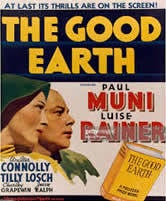
The film adaptation brings a vividness to farmers’ woes
Decades ago, I saw the film and was so impressed that I picked up the novel. I wasn’t wholly bored by the novel, but I was impatient. Scenes from the film that were (and still are) so memorable are subsumed in the novel’s accounts of subservience, indolence, foolish pride, and misogyny. The action scenes of the film – riots and recovery; the despair of famine and plague, the challenges and triumphs of a farmer and his wife – aggregate (by my eye and mind) to relatively few pages in the novel.
Now, decades later, I picked up the novel again – and again I became impatient; and struggled to get through the bestseller of 85 years ago.
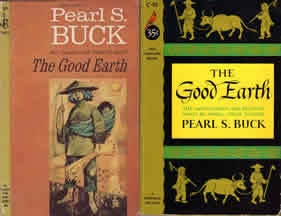
I decided to test my recollections of the film – and again I found much to marvel.
The screenwriters and filmmakers picked well from the novel, and conveyed so much of the drama and poignancy, in a most engaging way. For example, the revolution which has the masses storm the walls and bastions of the rich is related in just seven pages in the novel of 368 pages; but is vividly depicted in twelve minutes. The movie rewards.
The plague of locusts which serves to bring the film to a most dramatic resolve is related in a mere two pages in the novel; not even two full pages. The heroic efforts of the farmers to fend off the swarms of locusts make for a riveting and rewarding ten minutes in the film.
The 1930s special effects produced by microscope technology added to a camera lens are interspersed with Utah landscapes so that grasshoppers portray the ravaging locusts.
In present times, I wonder if the novel would receive anything remotely like the acclaim it won in 1932; I wonder if it would be published commercially.
The fate of females, and one woman’s wisdom
O-lan, the wife of the simple farmer Wang Lung, is the one wholly admirable character and the true hero of the story. For me, this was made all the more telling in the film.
Throughout the novel, a female baby of a poor family is referred to as “a slave” – and treated like chattel to be dispensed with (disposed of) as soon as the opportunity can be seized.
There’s infanticide and polygamy. All true to the lives and times witnessed by Pearl Buck, but would likely have the novel shunned by some grade schools, these days. Then again, in our supposedly enlightened times, misogyny, subservience, the repression and oppression, and mutilation, of females still obtains in many parts of the world.
In spite of repression, the incomparable good of an exceedingly good woman makes her the story’s most admirable character. O-lan is the perfect wife for the unworldly farmer Wang Lung, though it takes decades for him to realize it.
In the novel, she is described as “coarse-skinned… her features too large altogether and without any sort of beauty or light… her lips too wide, and her hands and feet too large and spreading.” She is “a woman whom no man could call other than she was, a dull and common creature, who plodded in silence without thought of how she appeared to others.” The reader is told that she is “inarticulate, dumb.”

She breaks earth with a hoe as steadfastly as Wang Lung, without a syllable of complaint. She wields a scythe at harvest time with the dedication and stamina of any man. She also cooks all the meals, sews all the family’s clothes, and, most significantly, takes only a few minutes away from cooking, sewing, and farming to bear three sons (no mid-wife, let alone a doctor).
The film captures much of this, even as O-lan is portrayed by the winsome, visually-appealing, Luise Rainer.
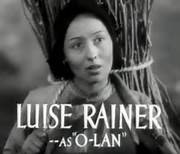
In time, unassertively, O-lan provides the resourcefulness and insights that astound Wang Lung. Belatedly, he comes to register her ingenuity, psychological astuteness, her advice regarding envy and pride; her solutions regarding rivalry and enmity.
The earth sustains in a number of ways
On the parched land thirsting for rain, O-lan stirs earth into heated water to make a gruel that “allayed the children’s craving for a time and put something into their distended, empty bellies.” The gruel has “some slight nutritious quality to it, although in the end it could not sustain life.”
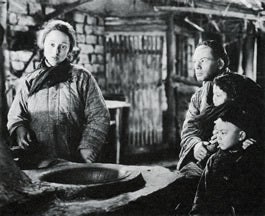
O-lan has psychological recipes to stave off despair and resignation.
Famine makes farmers foreigners
To escape starvation that would be their fate on their own parched land, Wang Lung and his family ride the “fire engine” whose railroad tracks take them to a southern city where they are alien – “like a rat in a rich man’s house” that survives by pilfering scraps that had been tossed away.
In these scenes, the film delivers more than a reader is apt to get from the novel, even as those scenes are drawn from the novel.
A country of stark contrasts
Famine is felt most intimately and intensely by the farmers who have to decide whether the few drops of water they can come by are to be offered to quench the thirst of their young, or be dribbled onto the parched land in the hope that some meager food crop might be brought to life.
“There was not a bean lost in the threshing. The two little boys were set to sifting the dust of the threshing floor between their fingers after Wang Lung and O-lan had flailed the bean vines, and after Wang Lung had shelled the corn upon the floor… watching sharply every grain that flew wide.”

When he would have put the cobs away for fuel, O-lan explained that they should not be wasted “in burning” but could be ground and eaten. As a child, soon to be sold into slavery by her destitute and desperate parents, she learned that the cobs might be made more palatable than grass.
Behind the great gates of the city, a lord cannot comprehend the words “no money.” For all his most privileged and insulated life, the lord “had but to reach out his hand and fill it with silver as often as he would.”
For Wang Lung, “a roll of good wheat bread and a sprig of garlic in it would be a good meal.” For years, he needed no more.
The southern city’s opulence was laid on the foundations of poverty – and Wang Lung’s family, along with many other evacuees from famine, supported that foundation.
In the city, food spilled out of the markets, and yet Wang Lung and other evacuees scavenged and starved. There was “not food enough to feed savage hunger.”
Men labored all day at the baking of breads and cakes for feasts of the rich. “Children labored from dawn to midnight, and slept, all greasy and grimed as they were, upon rough pallets on the floor. The next day, they staggered back to the ovens. There was no money given them to buy a piece of the rich breads they made for others.”
At harvest, the famished resort to “following reapers like fowls, their eyes piercing and sharp for every dropped grain or stalk or bit of cabbage.” They resort to begging and to petty theft, snatching what can be made away with quickly. They rest their hunger in damp-earth hovels.
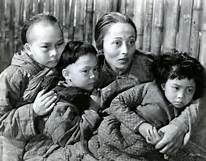
With what little they could scavenge or snatch or beg, they would fall asleep heavily “to gain that for their bodies which the refuse was too poor and too scanty to give.”
Rich soft-fleshed idle men were clothed in satin and velvet, with skin covered in garments of silk, while Wang Lung and other evacuees shivered through their rags.
When the barriers fall – literally – it is O-lan who manages to come away with the means for the family to return to the earth, and the good life that the earth can yield.
Through her mildness and awareness, Wang Lung (“a pig-tailed country bumpkin”) is able to again “know the heat of the sun on his body, and the purposeful weariness of walking back and forth along the furrows behind an ox.”

Reclaiming the earth is healing, again and again
The earth healed Wang Lung of a several maladies, the most diverting being a second wife, who is much disposed to exploiting her captive’s weakness, and the concubine’s unpleasant companion, who is as demanding and conniving as the trophy wife.
The moist soil at his bare feet was therapeutic, physically and mentally. A gratifying fragrance rose up from the freshly-plowed furrows; the eyes feasted on “the deep curl of earth” turned as the plow bit into the soil, “fine loamy stuff, soft as black sugar.”
His hands, “which had peeled off their callused parts under the idleness [that riches had provided] were hardened again where the hoe pressed and where the plow handles set their mark.”
Hoping sons will follow in the father’s furrows
In Marjorie Kinnan Rawlings’ The Yearling, the Baxters’ hardscrabble life challenges mother, father, and young son. At the very end of the novel, Pa Baxter says to his son, “You’re near enough growed to do your choosin’. Could be you’d crave to go to sea. There’s men seems made for the land, and men seems made for the sea. But I’d be proud did you choose to live here and farm the clearin’. I’d be proud to see the day when you got a well dug, so’s no woman here’d be obliged to do her washin’ on a seepage hillside. You willin’?” The boy responds, “I’m willin’.” They shake on it.
The film adaptation of The Good Earth well suggests that the sons will be satisfied with inheriting the earth. The novel indicates otherwise.
Unlike the difficult unsympathetic mother in The Yearling (and unlike the pampered, nervous overly-protective mother of Captains Courageous where, through comeuppance, the ultra-spoiled son seems made for the sea), O-lan protects her family with quiet insight and counsel, with sympathy that does not indulge but which informs and enlightens. O-lan’s goodness is that of a down-to-earth mother.
Accolades for the film
In its March 1937 issue, the Independent Woman credited the film with “spectacular effectiveness” in developing the story “with eloquence, poetry, and dramatic sweep.” The review asserted, “Probably no film has ever received more discriminating and universal acclaim.”
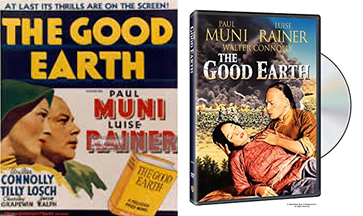
The New York Herald Tribune (February 3, 1937) declared that “Pearl Buck’s novel and the play that was fashioned from it have been brilliantly reworked on the screen. The film has tremendous elemental sweep, commanding characterizations, and striking spectacle. Chinese scholars may find it somewhat flavored with the Occidental temper, but Hollywood has done a remarkable job of keeping faith with the original.”
The San Francisco Chronicle (February 7, 1937) held that “As a novel The Good Earth was a fine, splendid thing, but only as a motion picture could it attain the heights of seeming immortality. No other medium could fittingly encompass this saga of the soil and its people.”
Pearl Buck’s critique of the film
In the April 1937 edition of the monthly magazine Asia, Pearl Buck championed the novel over the motion picture. She declared, “It is undoubtedly simpler, for one thing, to portray in pictures large plain actions and events than it is to show delicate character development, as in a novel.”
In that same magazine, a film critic wrote that Luise Rainer’s O-lan “almost inarticulate throughout… conveys to the audience the full measure of tragic and self-sacrificing devotion which makes the peasant woman a truly great character.”
In that same issue, a distinguished cultural observer who was Chinese wrote that the film’s representation of Chinese life had “an admirable sincerity.” Most touching of all, to his mind, was the moment in which O-lan retrieves a peach pit that Wang Lung had tossed aside in pride swelling by having shown off his first son to the elite of the Great House. O-lan holds “the peach kernel” close, foreseeing the day when it too will bear fruit.
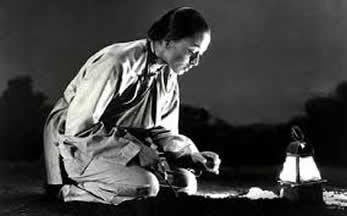
Even as the film blossomed Pearl Buck’s fictional chronicle, she expressed her displeasure with the medium. In her way, Pearl Buck was staking a claim on behalf of serious writers: She contended that while filmmakers develop images and special effects to create “the action of events,” serious writers develop characters who deal with such events, thus presenting internal dynamics as opposed to the external circumstances.
She wrote, “The motion picture finds its drama not in human beings but in the action of events, to which the human being is an incident. The story in this film, as in many others, is to be found in such happenings as storm, plagues, famines, mobs, and war…. To these events are attached certain small human beings, but their story is slight in contrast to the noise of the storm, the number of locusts, the madness of the mobs.”
Pearl Buck went on to proclaim, “The method of the novel is quite contrary to this. There the human being is more important than anything that happens to him, and indeed nothing does happen except as it happens to him. For the novel there is no storm except so much as affects the little group of humanity which makes its life from the land, there is no importance in drought except as it affects them, the mob is nothing except as it concerns Wang Lung and O-lan….”
Her critical contrasting continued: “In a word, the difference between the technique of the motion picture and that of the novel is that in the motion picture the dramatic effect is from incident, necessarily overemphasized in order to stir a public dulled by enormous scenic effects upon the screen, whereas in the novel the incident supplies the background, subdued in order that it may not overshadow the real drama, which is the interplay of human lives with each other primarily, and only secondarily with nature.
“Nature, indeed, provides only the atmosphere for human beings. It is the backdrop of their lives. Even in times of extremity, because of nature’s cruelty, this cruelty is not significant in itself, but only in its effect upon human life, in the change produced in human character and human relations.”
But then the very title of Pearl Buck’s sweeping novel is not the name of either main character – not the farmer, not his heroic wife. Instead – the role of nature is heralded. I think her title had it right.
